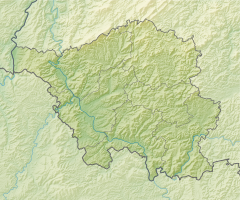Pit king
| Pit king | |||
|---|---|---|---|
| General information about the mine | |||
| The König Pit (1864) | |||
| Mining technology | Underground mining | ||
| Information about the mining company | |||
| Operating company | Saarbergwerke AG | ||
| Start of operation | 1820 | ||
| End of operation | 1968 | ||
| Funded raw materials | |||
| Degradation of | Hard coal | ||
| Geographical location | |||
| Coordinates | 49 ° 20 '19.6 " N , 7 ° 10' 8.7" E | ||
|
|||
| local community | Neunkirchen (Saar) | ||
| District ( NUTS3 ) | Neunkirchen | ||
| country | State of Saarland | ||
| Country | Germany | ||
| District | Saar | ||
The König pit is a former hard coal mine in Neunkirchen in Saarland .
history
The reason for the opening of the mine at the beginning of the 19th century was the lack of charcoal , which was needed to fire the blast furnaces in the ironworks in Neunkirchen. At the request of the Stumm brothers and at the instigation of the Royal Mining Authority in Saarbrücken, after evidence of several coal seams, work began in 1820 to dig a tunnel pit with daily routes . In 1828 the mine received a coking plant (until 1857). The mine was named after King Friedrich Wilhelm III. who visited Saarbrücken in 1821.
The main conveyor tunnel (Friedrich Wilhelm tunnel) was initially 53 m long and was continuously expanded and expanded in the following years. In 1844, however, at the renewed instigation of the Neunkirchener Hütte, a deep solution was sought and the main and extraction shaft Wilhelm shaft 1 was sunk. 1846 began tailgating the new water tunnel solution speeches in Klinkental, 1847 in Holzhauertal the Heinitz cleats attached. In 1851 the two new extraction sites became independent mines with the names Grube Heinitz and Grube Reden .
1854 another was awarded the Wilhelm Schacht 2 production well drilled and the Friedrich-Wilhelm-Stollen shut down. In 1857 the Ziehwaldstollen was built, which served as a conveyor and transport tunnel and met the railway line northwest of the Kuchenberg. In the following decades, the mine was greatly expanded: with the Follenius shaft (1867), the Mehlpfuhl shaft (1868–1887) and Wilhelm shaft 3 (1870), Hermine shafts 1 and 2 (1890) and 1893 the ventilation shaft Wilhelm 4. 1897 or 1898. teufte the Minna- and Sinnerthal from bay and finally struck in 1907 nor the effects of dewatering on serving Heusnersweiherschacht. In 1929, Hermine shaft 3 was sunk.
After the end of the Second World War , the König mine was systematically expanded and modernized. After the closure of the Heinitz mine on January 1, 1964, the previously independent König and Dechen mines were combined to form a composite mine. On March 31, 1968, the mine was shut down, the remaining stocks were dismantled from the Reden mine . The headframe of shaft Wilhelm 2 was dismantled in 1970 and erected on the Luisenthal mine.
Current situation
After the end of mining , the site was declared an industrial park. The old winding tower was preserved, as were some of the buildings in the König pit. The Neunkirchen waste-to-energy plant is also located on the site.
literature
- Delf Slotta: The Saarland coal mining industry. Verlag Krüger Druck und Verlag GmbH & Co. KG (Dillingen / Saar 2011), publisher: RAG Aktiengesellschaft (Herne) and Institute for Regional Studies in Saarland eV (Schiffweiler), ISBN 978-3-00-035206-5 .
Web links
Individual evidence
- ↑ a b Die Grube König , essay by Delf Slotta on the history of the pit
- ↑ Brief history of the Saar pits
- ↑ Monuments of hard coal mining in Saarland (PDF; 1.4 MB), Ministry for the Environment, Energy and Transport - State Monument Office, p. 3.

